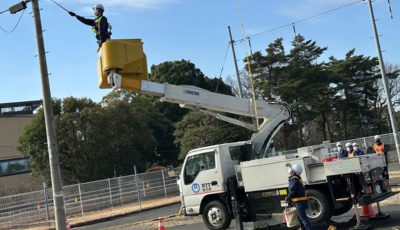“Restore culture as the bedrock of justice’
Editor’s Note: Kelvin Cepeda is a student at Mount Carmel School. The following is the text of his speech at the Attorney General Cup speech competition last May 4.
Ta fan un korason yan un taotao tånu’. This means “Let us be of one heart as one people.”
My family raised me learning this important lesson, which they inherited from ancestors who understood that justice was cultivated in a community, by the community, for the community.
But when we became a part of the American political family, instead of holding on to these communal values, we adopted the legal concept of individual rights. We moved away from what was good for the community and became more concerned about what’s good for me. But, standing before you today, I know that’s not who I am because I know that’s not who we are.
So, as much as the Insular Cases have helped the CNMI, I believe they have done more harm than good. That is because the Insular Cases stand on a judicial foundation that is fundamentally at odds with the core values and beliefs of our islands.
To justify my position, I will evaluate the Insular Cases Doctrine in three ways. First, I will discuss the history of the insular cases and how they have affected CNMI history and culture. Second, I will examine to what extent the Insular Cases Doctrine creates different classes of U.S. citizens. Third and last, I will use a critical legal studies framework to determine whether the Insular Cases Doctrine is still relevant and should continue applying to the CNMI.
To begin with, the history of the Insular Cases is rooted in American imperialism. After the U.S. acquired Guam, Puerto Rico, and the Philippines in the Spanish-American War, the Supreme Court, in 1901’s Downes vs. Bidwell, ruled that constitutional protections did not extend to all territories. This is why our founding fathers ensured that section 501 of the Covenant clearly identified what parts of the U.S. Constitution would and would not apply to the CNMI.
Over time, though, the Insular Cases were used to preserve the cultures of the unincorporated territories. For example, in 1990’s Wabol vs. Villacrusis, the Ninth Circuit ruled that landownership should be limited to the indigenous people, stating, “The Bill of Rights was not intended to operate as a genocide pact for diverse native cultures.” Similarly, 1999’s Rayphand vs. Sablan helped protect the people of Rota and Tinian from the tyranny of Saipan’s majority.
So, on one hand, the Insular Cases were an extension of American imperialism that denied constitutional rights to the territories. On the other hand, the Insular Cases have also been used to protect local land and culture.
This might be seen as a move in the right direction. However, there is a deeper conflict between the communal nature of local culture and the individualistic nature of American jurisprudence. This brings me to my second point.
While protecting culture, the Insular Cases Doctrine has been challenged for creating different classes of citizens. 2015’s Davis vs. Guam is a clear example of this. Based on laws that protect Chamorro ownership of land in Guam, Arnold Davis, an African-American, was evicted from his home after his wife, a native Chamorro, died without them having kids. And because he was not a native inhabitant of Guam, Davis could not even vote on a plebiscite about landownership. That’s when he sued the government of Guam for racial discrimination, and the Ninth Circuit Court ruled that Davis did suffer unfair treatment under the law.
But if you want to talk about unfair treatment under the law and creating different classes of citizens, then tell me this: Even though we have one of the highest rates of military enlistment in the country, why are we not included in federal policies like cabotage laws or the Affordable Care Act, we do not have a vote in Congress, and we cannot even vote for President? That, if anything, is unfair treatment under the law because it treats us as second-class citizens.
But, even if you put all that aside, in Davis vs. Guam, the court took a step away from its stance in Wabol vs. Villacrusis. And within the broader context of jurisprudence, this means that when pitted against individual rights, cultural rights are jeopardized.
Which brings me to my third, final, and most important point:
Is the Insular Cases Doctrine still relevant and should it continue applying to the CNMI? The real issue here is the judicial foundation on which that doctrine stands. According to critical legal studies, despite its façade of impartial objectivity, American jurisprudence has actually upheld the injustices of society’s power structures.
One need only look at a few Supreme Court rulings to see this.
1831: Cherokee Nation vs. Georgia sanctioned the Trail of Tears.
1857: Dred Scott vs. Sandford upheld slavery.
1896: Plessy vs. Ferguson legitimized segregation.
1944: Korematsu vs. United States condoned the unjust internment of Japanese-American citizens during World War II.
And 2000: Rice vs. Cayetano denied native Hawaiians the right to determine how their own indigenous affairs would be handled.
These are just some of the many Supreme Court rulings that have supported those in power by oppressing those without power.
And while other cases, like Brown vs. Board of Education, have upheld justice, they have been too piecemeal to have any lasting impact. Likewise, the piecemeal use of the Insular Cases Doctrine is not enough to protect cultures that have been historically wiped away. In a way, the Insular Cases Doctrine is too insular, and not big enough to address historical injustices like discrimination, oppression, or treating us like second-class citizens. These injustices were systematically and historically constructed, which is why they must be systematically and historically deconstructed.
At its foundation, American jurisprudence is based on individual rights. But when we look at Pacific islanders, our sense of justice is often rooted not in the individual but in the community.
That’s the problem.
While discussing the Insular Cases in a recent issue of the Harvard Law Review, Professor Rose Cuison Villazor of UC-Davis wrote that “when [there is] tension between the right of an individual against racial discrimination and the right of an indigenous group to [protect] their culture and autonomy,” the courts will often favor individual rights over cultural rights.
Now, don’t get me wrong. I believe that individual rights are important and that minorities should be protected. But I also believe that minorities would be better served by protecting group cultural rights over individual rights. Whether it be rising incarceration rates, increasing de facto segregation, or growing poverty, all of which hurt minorities the most, individual rights have failed to prevent these modern injustices because they focus on what’s happening to the individual, when these injustices are happening to groups of individuals. That is why we need a new kind of justice, one that is focused less on individuals and more on the community, one that goes beyond equality by upholding equity, and one that protects our island cultures. What we need is a restorative form of social justice that returns to our traditional values as indigenous people.
Throughout the Pacific, there are countless examples of restorative social justice, including New Zealand’s Maori. In traditional Maori culture, when a crime occurred, the entire tribe gathered to reach a consensus not to punish the individual but to restore what the Maori call “mana,” or the prestige of the victim, the offender, and their families.
This kind of restorative justice is something that many cultures throughout the Pacific share, including our own.
And while the Insular Cases Doctrine has attempted to protect our culture, its roots of imperialism and individualism are incapable of upholding the communal values of our cultures.
Besides, maybe we should stop treating culture as a victim that needs to be saved, and start treating it as something that saves us with values that we have not abandoned, whether it be the Pacific Judicial Council restoring traditional mediation, or the Family Court restoring peace in troubled families, or the Drug Court restoring hope for the many lives once thought lost to substance abuse.
Indeed, instead of using the Insular Cases and the justice system to protect culture, perhaps our culture can protect justice itself.
And maybe the best way to restore social justice is to restore culture as the bedrock of justice in our community. And return to what we all learned growing up: Let us be of one heart as one people. Ta fan un korason yan un taotao tånu’.



























